Cardiff Met Dental Technology: CAD/CAM Application Student Attitude
VerifiedAdded on 2020/06/04
|23
|4181
|176
Report
AI Summary
This report presents a study on undergraduate dental technology students' attitudes toward Computer-Aided Design/Computer-Aided Manufacturing (CAD/CAM) systems. A quantitative survey was administered to 60 students at Cardiff Metropolitan University to gather their views on CAD/CAM's application in dental technology. The research explores the extent of CAD/CAM usage, the students' perceived importance of CAD/CAM knowledge, and the time spent learning CAD/CAM basics. The findings reveal that while opinions vary, CAD/CAM involvement is generally seen as beneficial. The report includes tables and charts analyzing gender demographics, opinions on CAD/CAM's necessity, time spent on CAD/CAM basics, and students' self-assessed knowledge of CAD/CAM. Results indicate that most students believe CAD/CAM knowledge is essential and that more training is desired. The study concludes with recommendations for advanced technology implementation, improved training, and development within the dental technology curriculum. The report provides detailed analysis of the survey responses, including insights into the role of CAD and CAM in dental technology and the students' overall attitude toward these technologies.
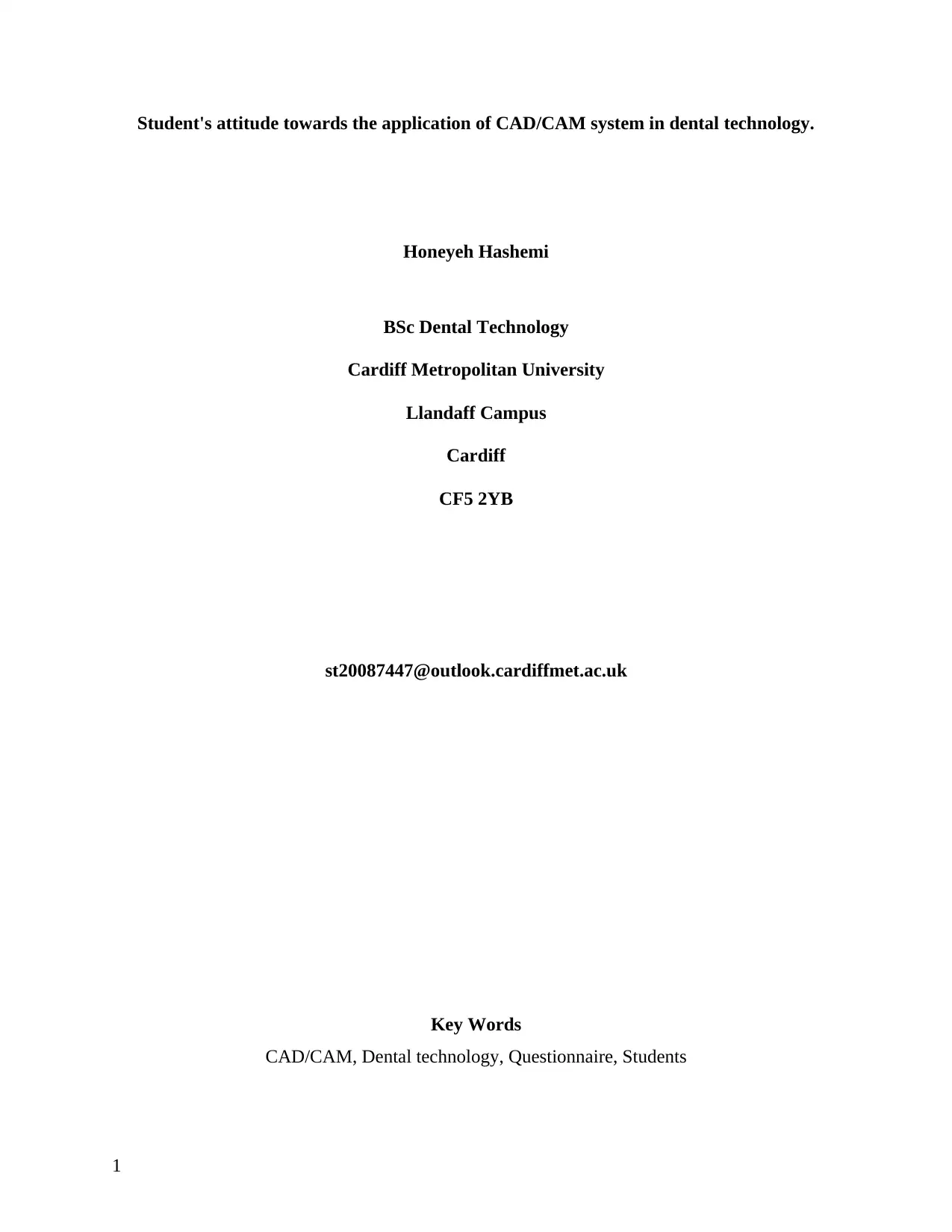
Student's attitude towards the application of CAD/CAM system in dental technology.
Honeyeh Hashemi
BSc Dental Technology
Cardiff Metropolitan University
Llandaff Campus
Cardiff
CF5 2YB
st20087447@outlook.cardiffmet.ac.uk
Key Words
CAD/CAM, Dental technology, Questionnaire, Students
1
Honeyeh Hashemi
BSc Dental Technology
Cardiff Metropolitan University
Llandaff Campus
Cardiff
CF5 2YB
st20087447@outlook.cardiffmet.ac.uk
Key Words
CAD/CAM, Dental technology, Questionnaire, Students
1
Paraphrase This Document
Need a fresh take? Get an instant paraphrase of this document with our AI Paraphraser
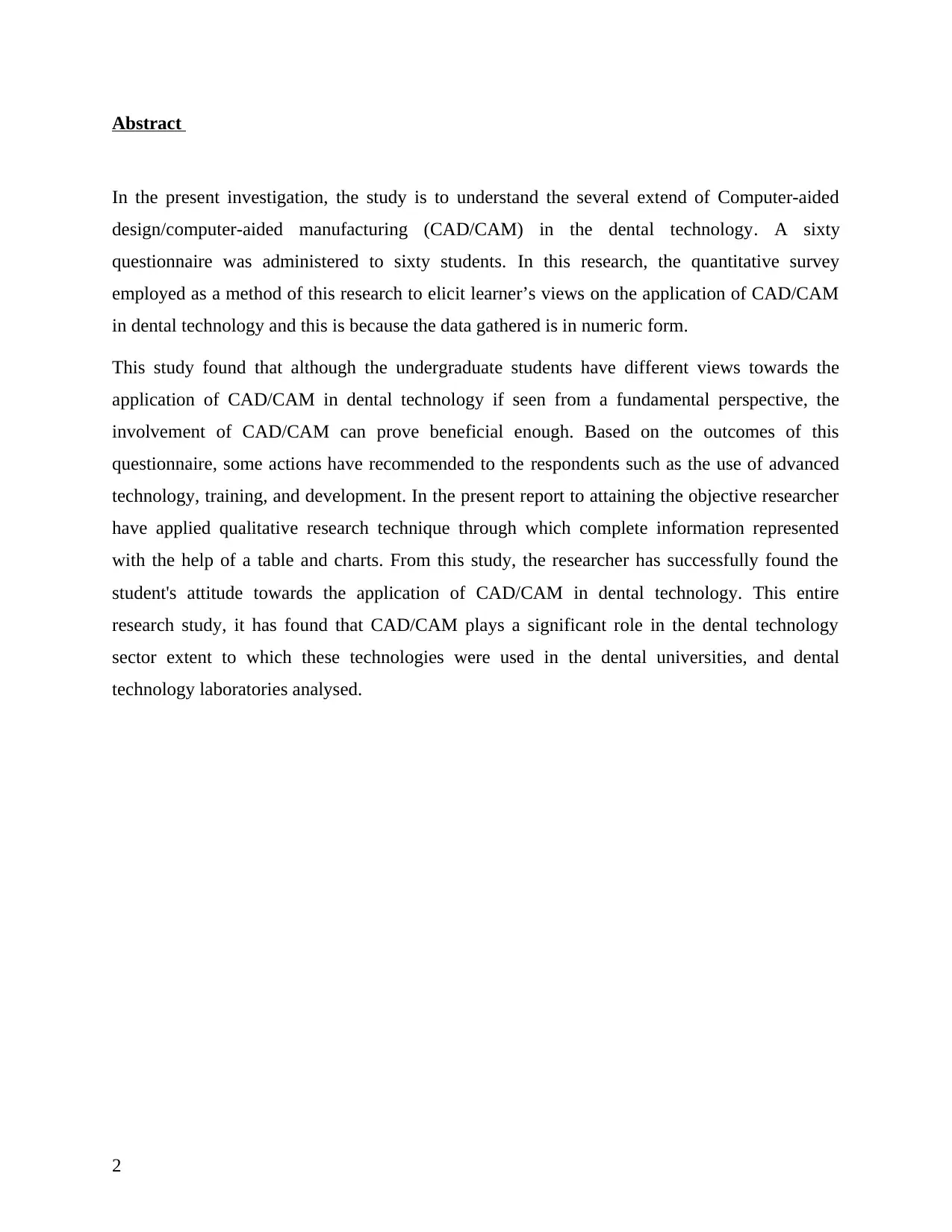
Abstract
In the present investigation, the study is to understand the several extend of Computer-aided
design/computer-aided manufacturing (CAD/CAM) in the dental technology. A sixty
questionnaire was administered to sixty students. In this research, the quantitative survey
employed as a method of this research to elicit learner’s views on the application of CAD/CAM
in dental technology and this is because the data gathered is in numeric form.
This study found that although the undergraduate students have different views towards the
application of CAD/CAM in dental technology if seen from a fundamental perspective, the
involvement of CAD/CAM can prove beneficial enough. Based on the outcomes of this
questionnaire, some actions have recommended to the respondents such as the use of advanced
technology, training, and development. In the present report to attaining the objective researcher
have applied qualitative research technique through which complete information represented
with the help of a table and charts. From this study, the researcher has successfully found the
student's attitude towards the application of CAD/CAM in dental technology. This entire
research study, it has found that CAD/CAM plays a significant role in the dental technology
sector extent to which these technologies were used in the dental universities, and dental
technology laboratories analysed.
2
In the present investigation, the study is to understand the several extend of Computer-aided
design/computer-aided manufacturing (CAD/CAM) in the dental technology. A sixty
questionnaire was administered to sixty students. In this research, the quantitative survey
employed as a method of this research to elicit learner’s views on the application of CAD/CAM
in dental technology and this is because the data gathered is in numeric form.
This study found that although the undergraduate students have different views towards the
application of CAD/CAM in dental technology if seen from a fundamental perspective, the
involvement of CAD/CAM can prove beneficial enough. Based on the outcomes of this
questionnaire, some actions have recommended to the respondents such as the use of advanced
technology, training, and development. In the present report to attaining the objective researcher
have applied qualitative research technique through which complete information represented
with the help of a table and charts. From this study, the researcher has successfully found the
student's attitude towards the application of CAD/CAM in dental technology. This entire
research study, it has found that CAD/CAM plays a significant role in the dental technology
sector extent to which these technologies were used in the dental universities, and dental
technology laboratories analysed.
2
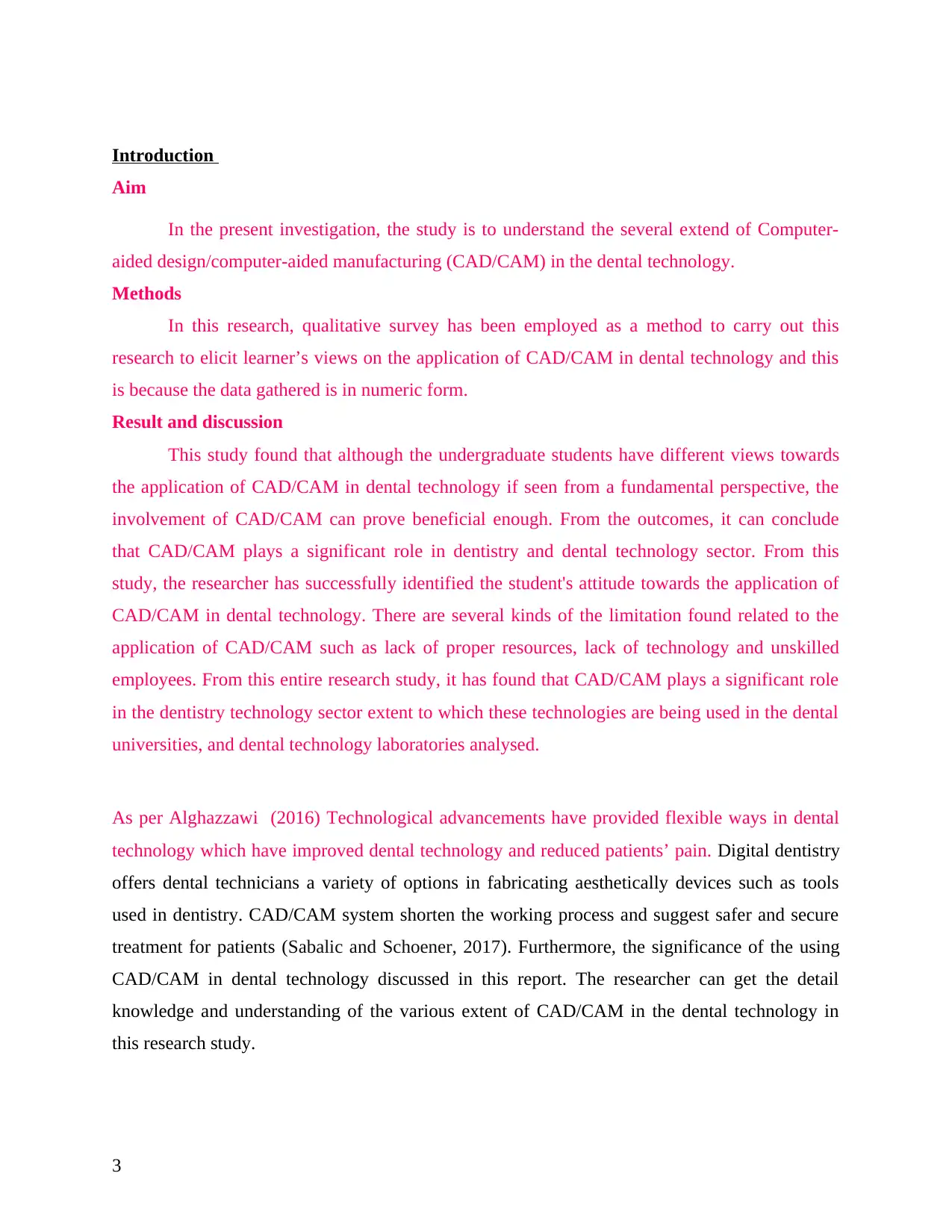
Introduction
Aim
In the present investigation, the study is to understand the several extend of Computer-
aided design/computer-aided manufacturing (CAD/CAM) in the dental technology.
Methods
In this research, qualitative survey has been employed as a method to carry out this
research to elicit learner’s views on the application of CAD/CAM in dental technology and this
is because the data gathered is in numeric form.
Result and discussion
This study found that although the undergraduate students have different views towards
the application of CAD/CAM in dental technology if seen from a fundamental perspective, the
involvement of CAD/CAM can prove beneficial enough. From the outcomes, it can conclude
that CAD/CAM plays a significant role in dentistry and dental technology sector. From this
study, the researcher has successfully identified the student's attitude towards the application of
CAD/CAM in dental technology. There are several kinds of the limitation found related to the
application of CAD/CAM such as lack of proper resources, lack of technology and unskilled
employees. From this entire research study, it has found that CAD/CAM plays a significant role
in the dentistry technology sector extent to which these technologies are being used in the dental
universities, and dental technology laboratories analysed.
As per Alghazzawi (2016) Technological advancements have provided flexible ways in dental
technology which have improved dental technology and reduced patients’ pain. Digital dentistry
offers dental technicians a variety of options in fabricating aesthetically devices such as tools
used in dentistry. CAD/CAM system shorten the working process and suggest safer and secure
treatment for patients (Sabalic and Schoener, 2017). Furthermore, the significance of the using
CAD/CAM in dental technology discussed in this report. The researcher can get the detail
knowledge and understanding of the various extent of CAD/CAM in the dental technology in
this research study.
3
Aim
In the present investigation, the study is to understand the several extend of Computer-
aided design/computer-aided manufacturing (CAD/CAM) in the dental technology.
Methods
In this research, qualitative survey has been employed as a method to carry out this
research to elicit learner’s views on the application of CAD/CAM in dental technology and this
is because the data gathered is in numeric form.
Result and discussion
This study found that although the undergraduate students have different views towards
the application of CAD/CAM in dental technology if seen from a fundamental perspective, the
involvement of CAD/CAM can prove beneficial enough. From the outcomes, it can conclude
that CAD/CAM plays a significant role in dentistry and dental technology sector. From this
study, the researcher has successfully identified the student's attitude towards the application of
CAD/CAM in dental technology. There are several kinds of the limitation found related to the
application of CAD/CAM such as lack of proper resources, lack of technology and unskilled
employees. From this entire research study, it has found that CAD/CAM plays a significant role
in the dentistry technology sector extent to which these technologies are being used in the dental
universities, and dental technology laboratories analysed.
As per Alghazzawi (2016) Technological advancements have provided flexible ways in dental
technology which have improved dental technology and reduced patients’ pain. Digital dentistry
offers dental technicians a variety of options in fabricating aesthetically devices such as tools
used in dentistry. CAD/CAM system shorten the working process and suggest safer and secure
treatment for patients (Sabalic and Schoener, 2017). Furthermore, the significance of the using
CAD/CAM in dental technology discussed in this report. The researcher can get the detail
knowledge and understanding of the various extent of CAD/CAM in the dental technology in
this research study.
3
⊘ This is a preview!⊘
Do you want full access?
Subscribe today to unlock all pages.

Trusted by 1+ million students worldwide
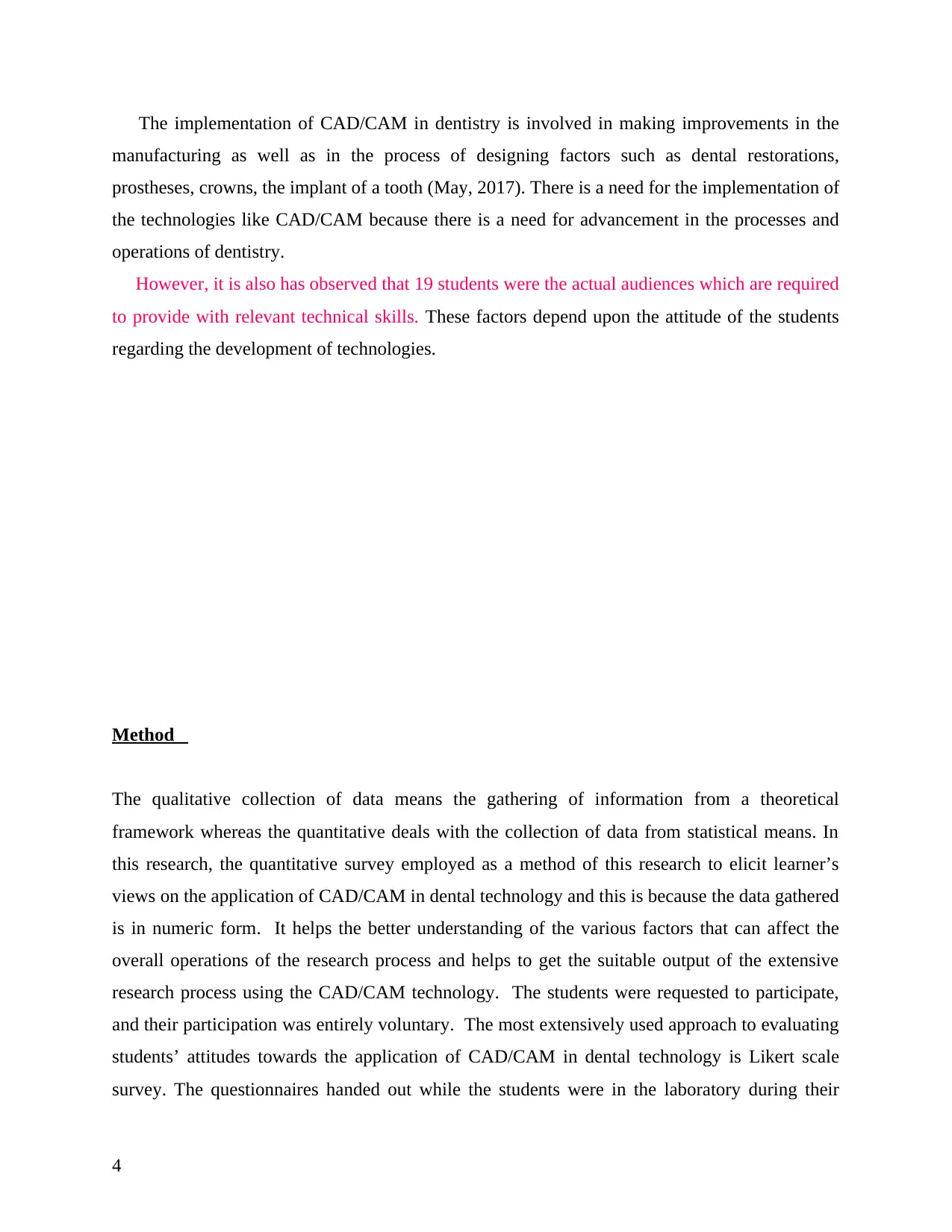
The implementation of CAD/CAM in dentistry is involved in making improvements in the
manufacturing as well as in the process of designing factors such as dental restorations,
prostheses, crowns, the implant of a tooth (May, 2017). There is a need for the implementation of
the technologies like CAD/CAM because there is a need for advancement in the processes and
operations of dentistry.
However, it is also has observed that 19 students were the actual audiences which are required
to provide with relevant technical skills. These factors depend upon the attitude of the students
regarding the development of technologies.
Method
The qualitative collection of data means the gathering of information from a theoretical
framework whereas the quantitative deals with the collection of data from statistical means. In
this research, the quantitative survey employed as a method of this research to elicit learner’s
views on the application of CAD/CAM in dental technology and this is because the data gathered
is in numeric form. It helps the better understanding of the various factors that can affect the
overall operations of the research process and helps to get the suitable output of the extensive
research process using the CAD/CAM technology. The students were requested to participate,
and their participation was entirely voluntary. The most extensively used approach to evaluating
students’ attitudes towards the application of CAD/CAM in dental technology is Likert scale
survey. The questionnaires handed out while the students were in the laboratory during their
4
manufacturing as well as in the process of designing factors such as dental restorations,
prostheses, crowns, the implant of a tooth (May, 2017). There is a need for the implementation of
the technologies like CAD/CAM because there is a need for advancement in the processes and
operations of dentistry.
However, it is also has observed that 19 students were the actual audiences which are required
to provide with relevant technical skills. These factors depend upon the attitude of the students
regarding the development of technologies.
Method
The qualitative collection of data means the gathering of information from a theoretical
framework whereas the quantitative deals with the collection of data from statistical means. In
this research, the quantitative survey employed as a method of this research to elicit learner’s
views on the application of CAD/CAM in dental technology and this is because the data gathered
is in numeric form. It helps the better understanding of the various factors that can affect the
overall operations of the research process and helps to get the suitable output of the extensive
research process using the CAD/CAM technology. The students were requested to participate,
and their participation was entirely voluntary. The most extensively used approach to evaluating
students’ attitudes towards the application of CAD/CAM in dental technology is Likert scale
survey. The questionnaires handed out while the students were in the laboratory during their
4
Paraphrase This Document
Need a fresh take? Get an instant paraphrase of this document with our AI Paraphraser
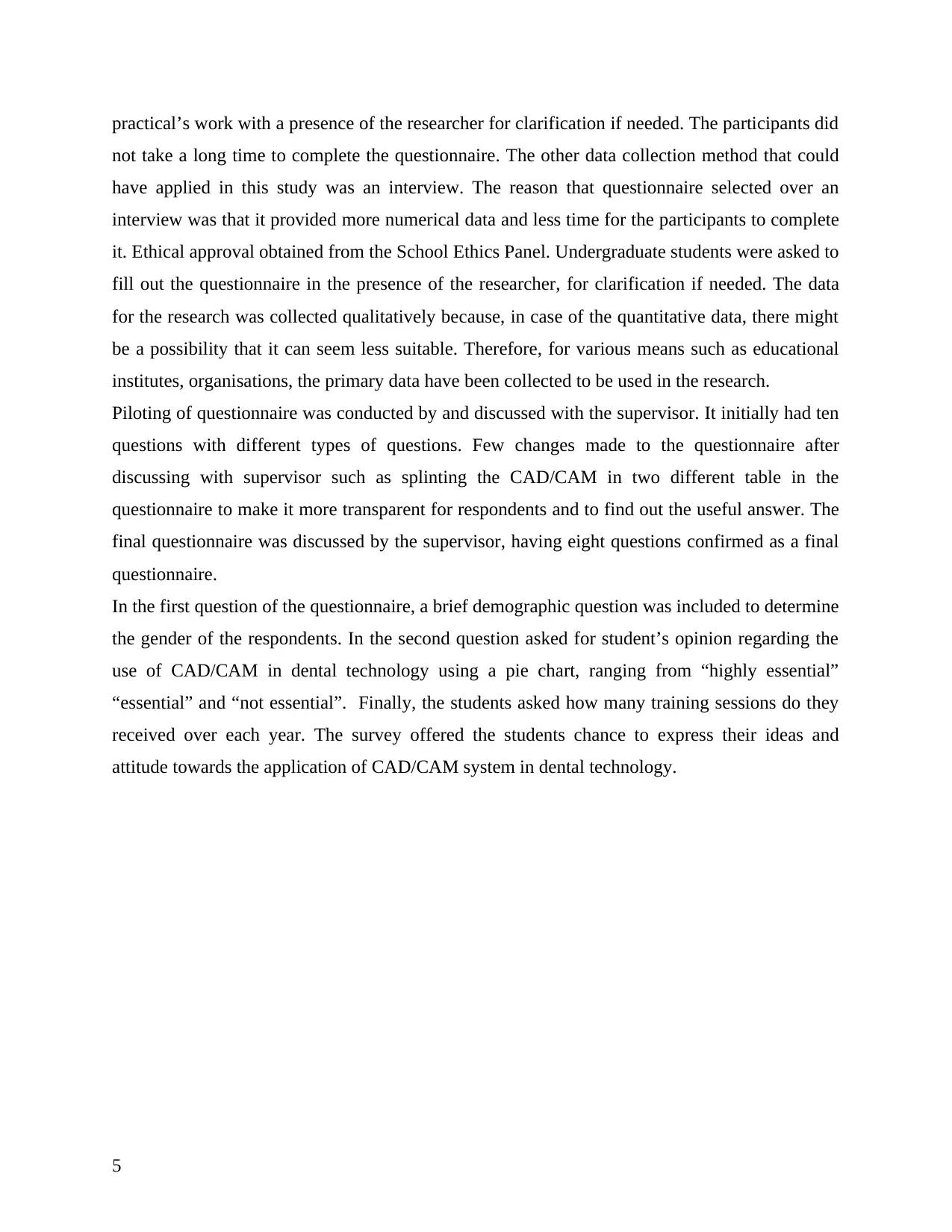
practical’s work with a presence of the researcher for clarification if needed. The participants did
not take a long time to complete the questionnaire. The other data collection method that could
have applied in this study was an interview. The reason that questionnaire selected over an
interview was that it provided more numerical data and less time for the participants to complete
it. Ethical approval obtained from the School Ethics Panel. Undergraduate students were asked to
fill out the questionnaire in the presence of the researcher, for clarification if needed. The data
for the research was collected qualitatively because, in case of the quantitative data, there might
be a possibility that it can seem less suitable. Therefore, for various means such as educational
institutes, organisations, the primary data have been collected to be used in the research.
Piloting of questionnaire was conducted by and discussed with the supervisor. It initially had ten
questions with different types of questions. Few changes made to the questionnaire after
discussing with supervisor such as splinting the CAD/CAM in two different table in the
questionnaire to make it more transparent for respondents and to find out the useful answer. The
final questionnaire was discussed by the supervisor, having eight questions confirmed as a final
questionnaire.
In the first question of the questionnaire, a brief demographic question was included to determine
the gender of the respondents. In the second question asked for student’s opinion regarding the
use of CAD/CAM in dental technology using a pie chart, ranging from “highly essential”
“essential” and “not essential”. Finally, the students asked how many training sessions do they
received over each year. The survey offered the students chance to express their ideas and
attitude towards the application of CAD/CAM system in dental technology.
5
not take a long time to complete the questionnaire. The other data collection method that could
have applied in this study was an interview. The reason that questionnaire selected over an
interview was that it provided more numerical data and less time for the participants to complete
it. Ethical approval obtained from the School Ethics Panel. Undergraduate students were asked to
fill out the questionnaire in the presence of the researcher, for clarification if needed. The data
for the research was collected qualitatively because, in case of the quantitative data, there might
be a possibility that it can seem less suitable. Therefore, for various means such as educational
institutes, organisations, the primary data have been collected to be used in the research.
Piloting of questionnaire was conducted by and discussed with the supervisor. It initially had ten
questions with different types of questions. Few changes made to the questionnaire after
discussing with supervisor such as splinting the CAD/CAM in two different table in the
questionnaire to make it more transparent for respondents and to find out the useful answer. The
final questionnaire was discussed by the supervisor, having eight questions confirmed as a final
questionnaire.
In the first question of the questionnaire, a brief demographic question was included to determine
the gender of the respondents. In the second question asked for student’s opinion regarding the
use of CAD/CAM in dental technology using a pie chart, ranging from “highly essential”
“essential” and “not essential”. Finally, the students asked how many training sessions do they
received over each year. The survey offered the students chance to express their ideas and
attitude towards the application of CAD/CAM system in dental technology.
5
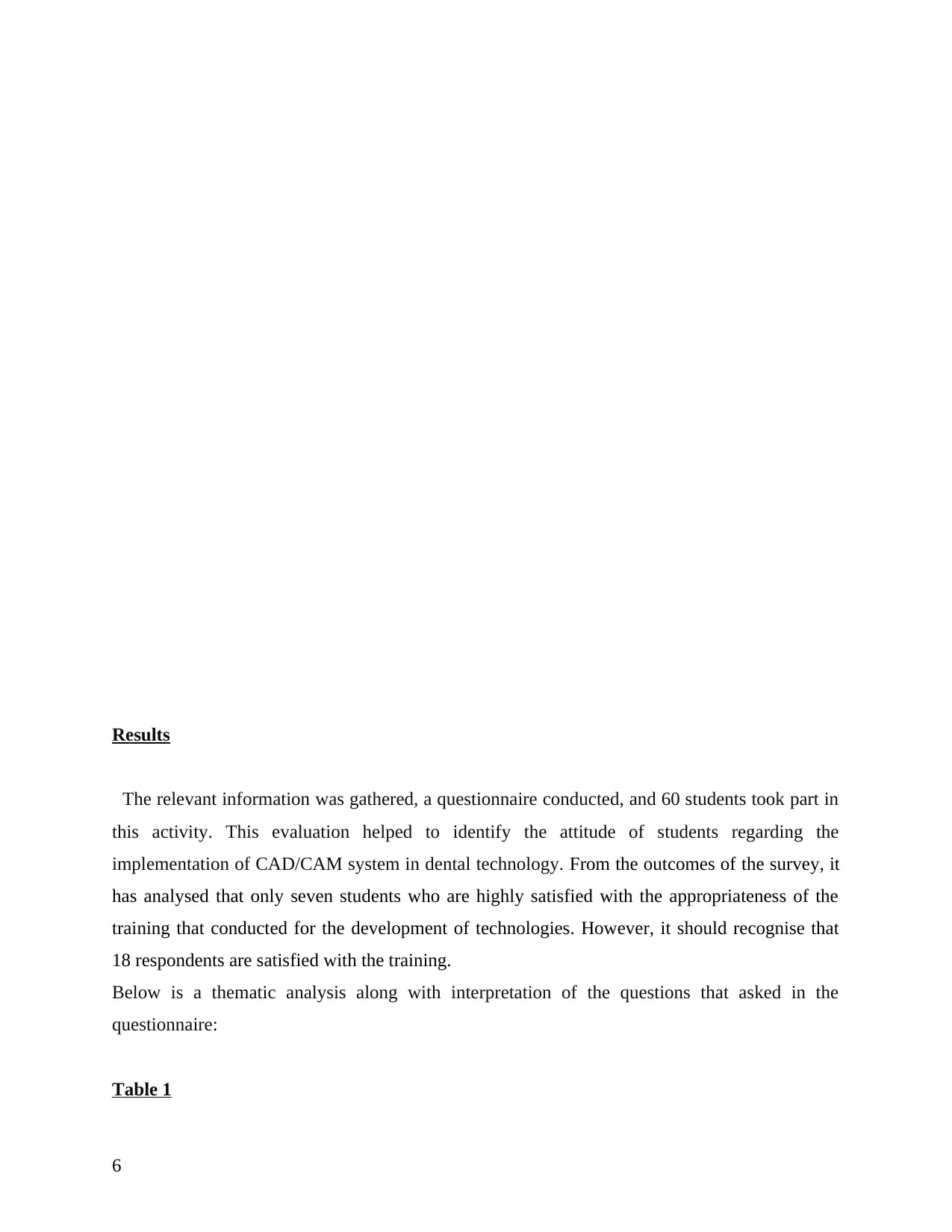
Results
The relevant information was gathered, a questionnaire conducted, and 60 students took part in
this activity. This evaluation helped to identify the attitude of students regarding the
implementation of CAD/CAM system in dental technology. From the outcomes of the survey, it
has analysed that only seven students who are highly satisfied with the appropriateness of the
training that conducted for the development of technologies. However, it should recognise that
18 respondents are satisfied with the training.
Below is a thematic analysis along with interpretation of the questions that asked in the
questionnaire:
Table 1
6
The relevant information was gathered, a questionnaire conducted, and 60 students took part in
this activity. This evaluation helped to identify the attitude of students regarding the
implementation of CAD/CAM system in dental technology. From the outcomes of the survey, it
has analysed that only seven students who are highly satisfied with the appropriateness of the
training that conducted for the development of technologies. However, it should recognise that
18 respondents are satisfied with the training.
Below is a thematic analysis along with interpretation of the questions that asked in the
questionnaire:
Table 1
6
⊘ This is a preview!⊘
Do you want full access?
Subscribe today to unlock all pages.

Trusted by 1+ million students worldwide
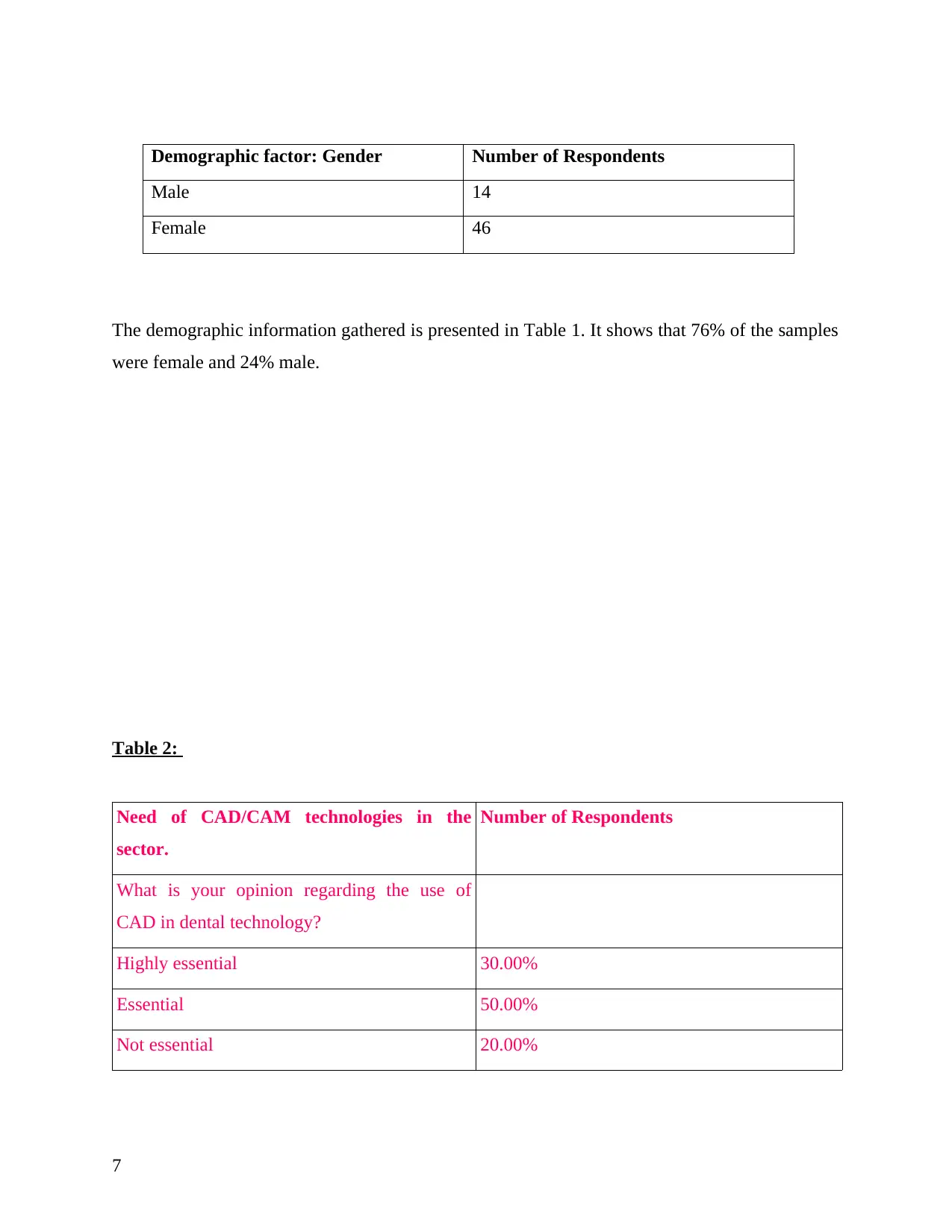
Demographic factor: Gender Number of Respondents
Male 14
Female 46
The demographic information gathered is presented in Table 1. It shows that 76% of the samples
were female and 24% male.
Table 2:
Need of CAD/CAM technologies in the
sector.
Number of Respondents
What is your opinion regarding the use of
CAD in dental technology?
Highly essential 30.00%
Essential 50.00%
Not essential 20.00%
7
Male 14
Female 46
The demographic information gathered is presented in Table 1. It shows that 76% of the samples
were female and 24% male.
Table 2:
Need of CAD/CAM technologies in the
sector.
Number of Respondents
What is your opinion regarding the use of
CAD in dental technology?
Highly essential 30.00%
Essential 50.00%
Not essential 20.00%
7
Paraphrase This Document
Need a fresh take? Get an instant paraphrase of this document with our AI Paraphraser
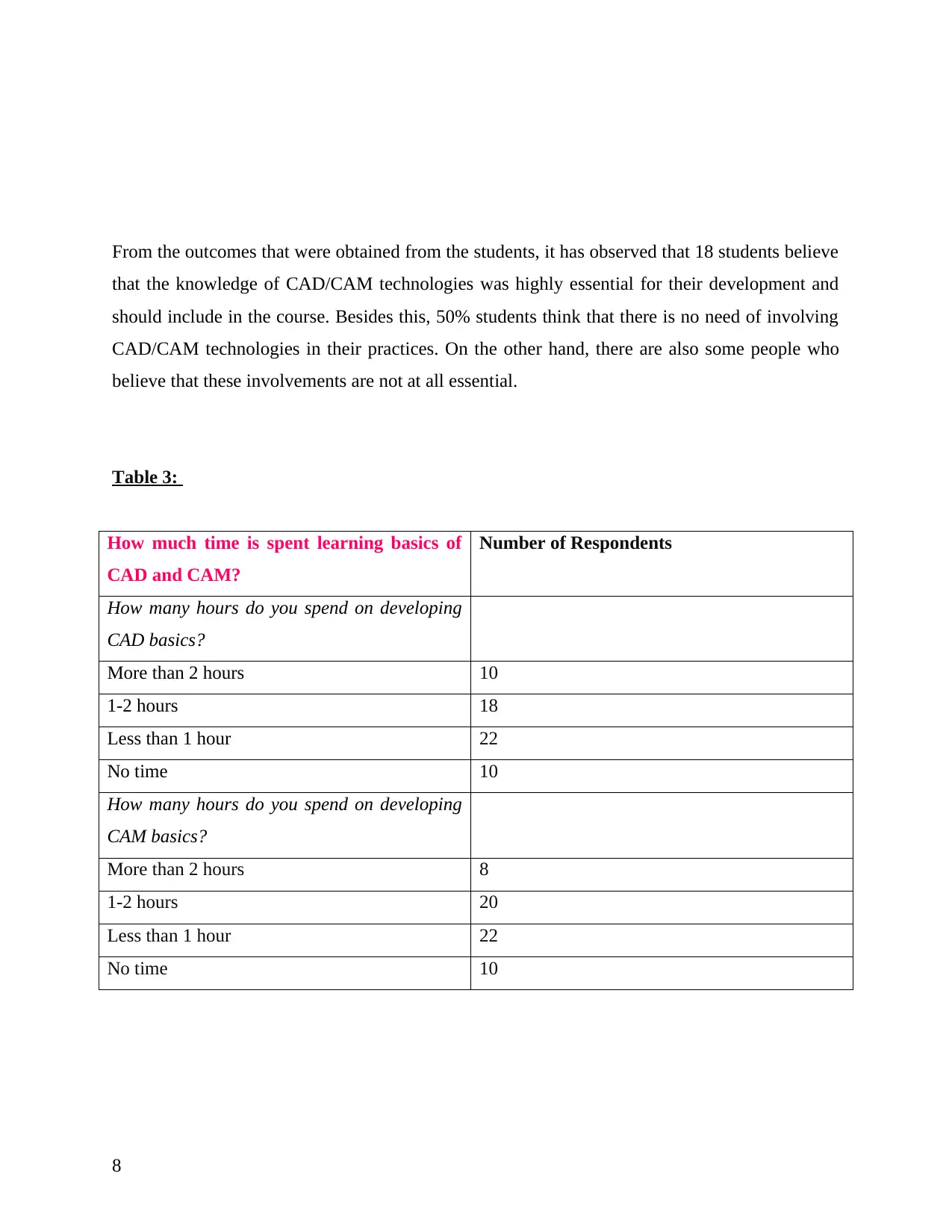
From the outcomes that were obtained from the students, it has observed that 18 students believe
that the knowledge of CAD/CAM technologies was highly essential for their development and
should include in the course. Besides this, 50% students think that there is no need of involving
CAD/CAM technologies in their practices. On the other hand, there are also some people who
believe that these involvements are not at all essential.
Table 3:
How much time is spent learning basics of
CAD and CAM?
Number of Respondents
How many hours do you spend on developing
CAD basics?
More than 2 hours 10
1-2 hours 18
Less than 1 hour 22
No time 10
How many hours do you spend on developing
CAM basics?
More than 2 hours 8
1-2 hours 20
Less than 1 hour 22
No time 10
8
that the knowledge of CAD/CAM technologies was highly essential for their development and
should include in the course. Besides this, 50% students think that there is no need of involving
CAD/CAM technologies in their practices. On the other hand, there are also some people who
believe that these involvements are not at all essential.
Table 3:
How much time is spent learning basics of
CAD and CAM?
Number of Respondents
How many hours do you spend on developing
CAD basics?
More than 2 hours 10
1-2 hours 18
Less than 1 hour 22
No time 10
How many hours do you spend on developing
CAM basics?
More than 2 hours 8
1-2 hours 20
Less than 1 hour 22
No time 10
8
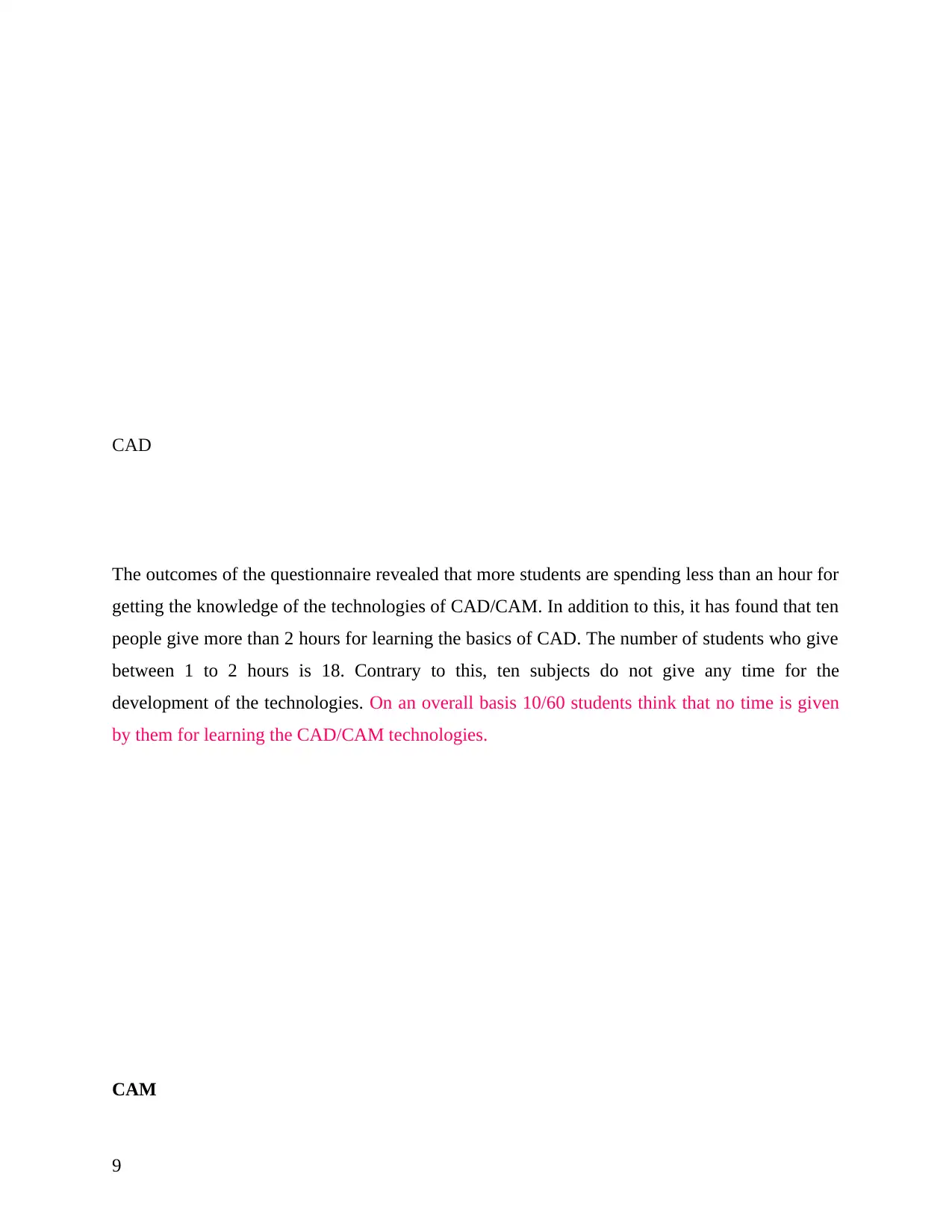
CAD
The outcomes of the questionnaire revealed that more students are spending less than an hour for
getting the knowledge of the technologies of CAD/CAM. In addition to this, it has found that ten
people give more than 2 hours for learning the basics of CAD. The number of students who give
between 1 to 2 hours is 18. Contrary to this, ten subjects do not give any time for the
development of the technologies. On an overall basis 10/60 students think that no time is given
by them for learning the CAD/CAM technologies.
CAM
9
The outcomes of the questionnaire revealed that more students are spending less than an hour for
getting the knowledge of the technologies of CAD/CAM. In addition to this, it has found that ten
people give more than 2 hours for learning the basics of CAD. The number of students who give
between 1 to 2 hours is 18. Contrary to this, ten subjects do not give any time for the
development of the technologies. On an overall basis 10/60 students think that no time is given
by them for learning the CAD/CAM technologies.
CAM
9
⊘ This is a preview!⊘
Do you want full access?
Subscribe today to unlock all pages.

Trusted by 1+ million students worldwide
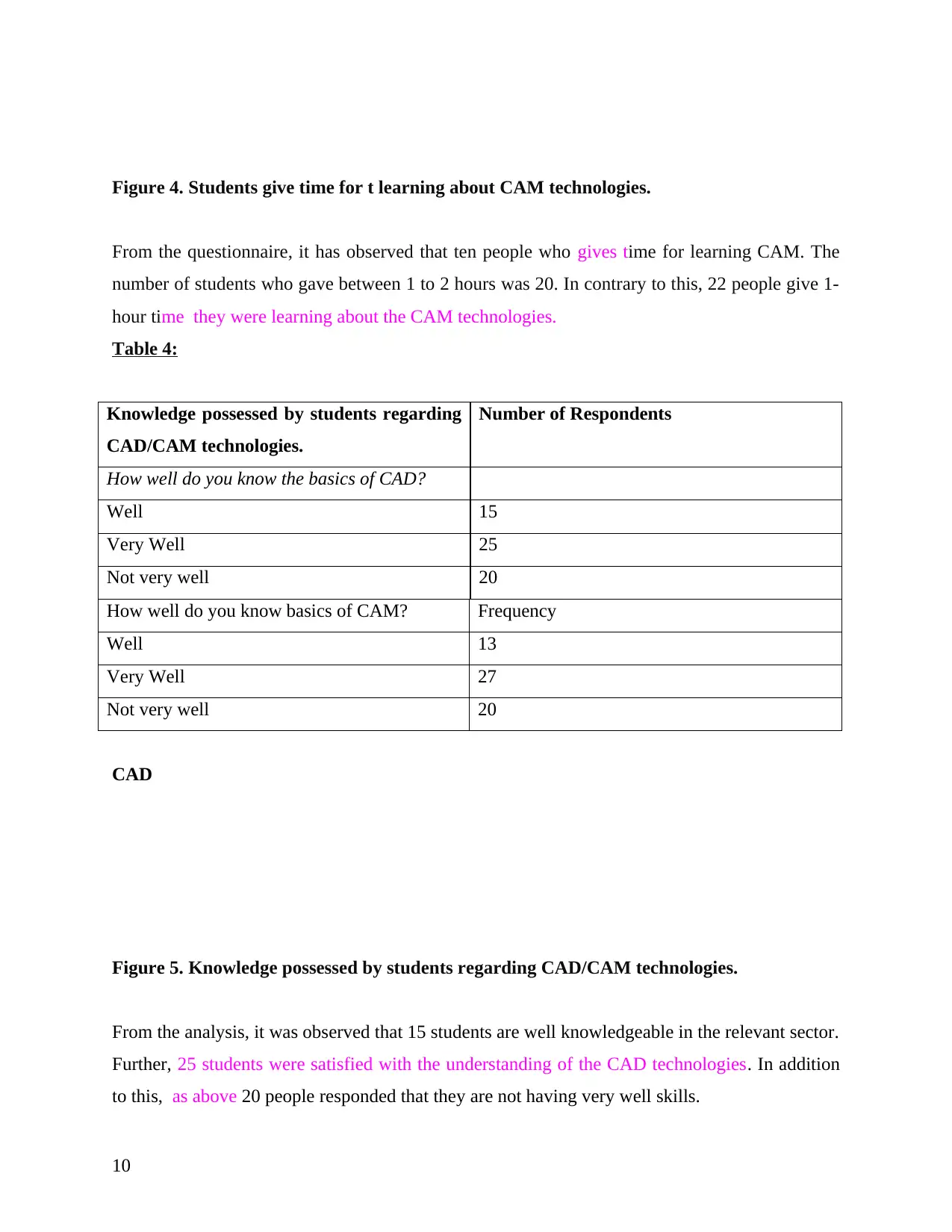
Figure 4. Students give time for t learning about CAM technologies.
From the questionnaire, it has observed that ten people who gives time for learning CAM. The
number of students who gave between 1 to 2 hours was 20. In contrary to this, 22 people give 1-
hour time they were learning about the CAM technologies.
Table 4:
Knowledge possessed by students regarding
CAD/CAM technologies.
Number of Respondents
How well do you know the basics of CAD?
Well 15
Very Well 25
Not very well 20
How well do you know basics of CAM? Frequency
Well 13
Very Well 27
Not very well 20
CAD
Figure 5. Knowledge possessed by students regarding CAD/CAM technologies.
From the analysis, it was observed that 15 students are well knowledgeable in the relevant sector.
Further, 25 students were satisfied with the understanding of the CAD technologies. In addition
to this, as above 20 people responded that they are not having very well skills.
10
From the questionnaire, it has observed that ten people who gives time for learning CAM. The
number of students who gave between 1 to 2 hours was 20. In contrary to this, 22 people give 1-
hour time they were learning about the CAM technologies.
Table 4:
Knowledge possessed by students regarding
CAD/CAM technologies.
Number of Respondents
How well do you know the basics of CAD?
Well 15
Very Well 25
Not very well 20
How well do you know basics of CAM? Frequency
Well 13
Very Well 27
Not very well 20
CAD
Figure 5. Knowledge possessed by students regarding CAD/CAM technologies.
From the analysis, it was observed that 15 students are well knowledgeable in the relevant sector.
Further, 25 students were satisfied with the understanding of the CAD technologies. In addition
to this, as above 20 people responded that they are not having very well skills.
10
Paraphrase This Document
Need a fresh take? Get an instant paraphrase of this document with our AI Paraphraser
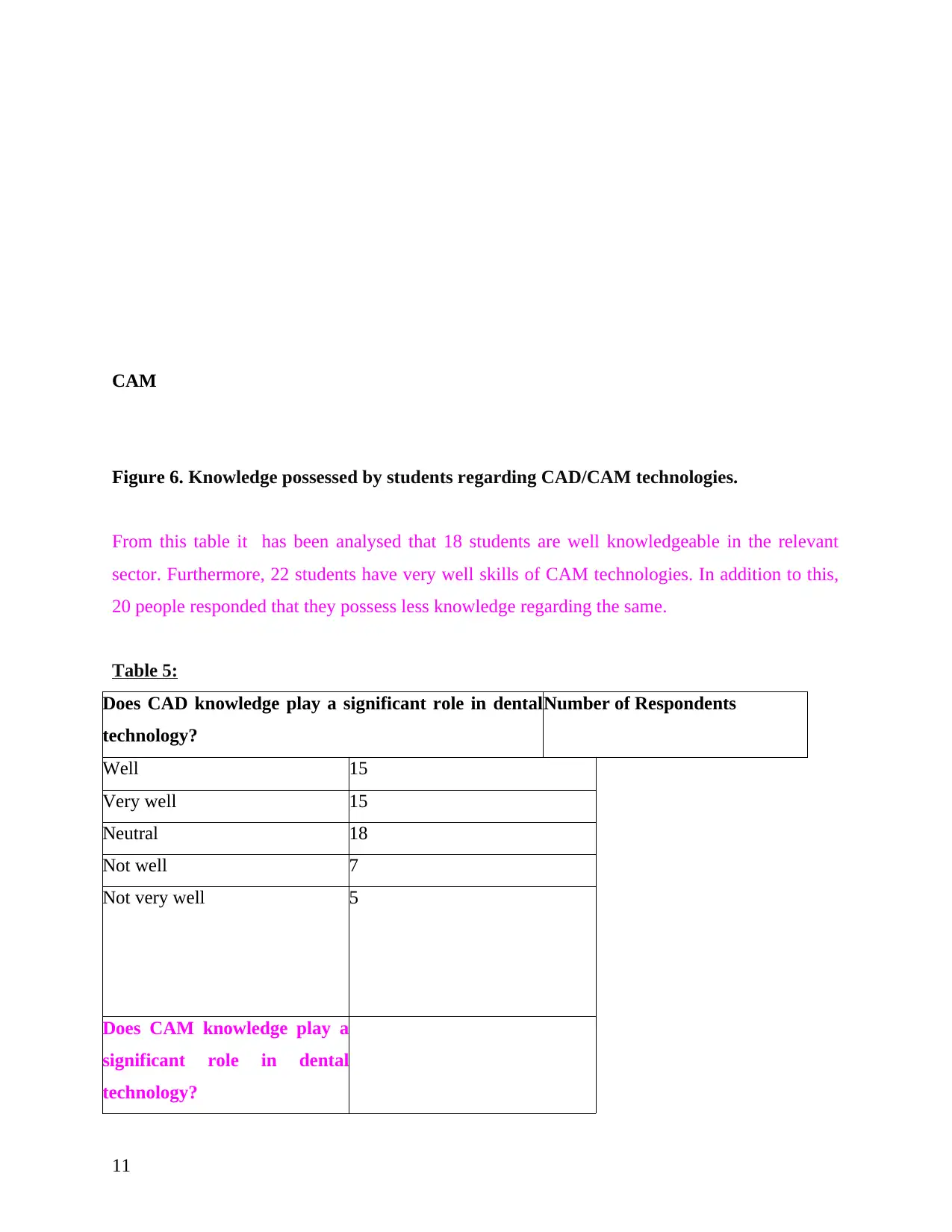
CAM
Figure 6. Knowledge possessed by students regarding CAD/CAM technologies.
From this table it has been analysed that 18 students are well knowledgeable in the relevant
sector. Furthermore, 22 students have very well skills of CAM technologies. In addition to this,
20 people responded that they possess less knowledge regarding the same.
Table 5:
Does CAD knowledge play a significant role in dental
technology?
Number of Respondents
Well 15
Very well 15
Neutral 18
Not well 7
Not very well 5
Does CAM knowledge play a
significant role in dental
technology?
11
Figure 6. Knowledge possessed by students regarding CAD/CAM technologies.
From this table it has been analysed that 18 students are well knowledgeable in the relevant
sector. Furthermore, 22 students have very well skills of CAM technologies. In addition to this,
20 people responded that they possess less knowledge regarding the same.
Table 5:
Does CAD knowledge play a significant role in dental
technology?
Number of Respondents
Well 15
Very well 15
Neutral 18
Not well 7
Not very well 5
Does CAM knowledge play a
significant role in dental
technology?
11

well 10
Neutral 17
Not well 20
Not very well 8
Very well 5
12
Neutral 17
Not well 20
Not very well 8
Very well 5
12
⊘ This is a preview!⊘
Do you want full access?
Subscribe today to unlock all pages.

Trusted by 1+ million students worldwide
1 out of 23
Your All-in-One AI-Powered Toolkit for Academic Success.
+13062052269
info@desklib.com
Available 24*7 on WhatsApp / Email
![[object Object]](/_next/static/media/star-bottom.7253800d.svg)
Unlock your academic potential
Copyright © 2020–2025 A2Z Services. All Rights Reserved. Developed and managed by ZUCOL.

